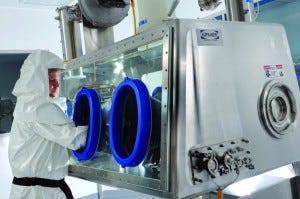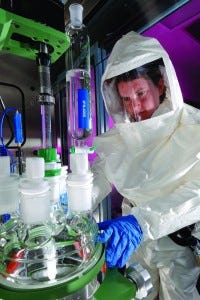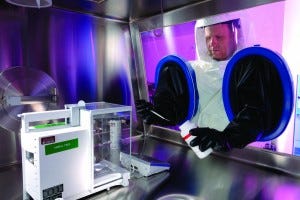Using a CMO for Your ADC: Access Analytical and Manufacturing Platforms, Specialized Facilities, and ExpertiseUsing a CMO for Your ADC: Access Analytical and Manufacturing Platforms, Specialized Facilities, and Expertise
October 15, 2014
Antibody–drug conjugates (ADCs) are an exciting new area of therapeutics. They bring the “magic bullet” that was promised by Paul Ehrlich over a hundred years ago to reality by targeting cancer cells to deliver chemotherapies without poisoning a patient’s whole body. ADCs offer a promising form of therapy by providing higher safety margins than traditional chemotherapeutics alone, and they make selectivity possible. We should be able to personalize a therapy to the specific cancer expressed in a given individual.
Why choose to work with a contract manufacturing organization (CMO) for developing and manufacturing your ADC products? These are complex molecules, requiring expertise both in handling biologics (the antibody portion of the drug) and highly potent active pharmaceutical ingredients (HPAPI), as well as drug linkers and associated chemistry. Specialized containment is required to protect personnel handling highly potent ingredients. Conjugates with both biological and chemical attributes also make very sophisticated analytical techniques necessary.
In addition, ADCs involve a very complicated supply chain that must be well coordinated to get all required components together. First, the monoclonal antibody (MAb) must be manufactured. For most CMOs, the client will supply that antibody or provide appropriate expression for it. The linker and payload (drug toxin) also must be obtained. The manufacturer then must be able to perform conjugation activities, provide appropriate testing and characterization, formulate and finish the final product, and then perform corresponding stability studies and put together a regulatory package to support filing for market authorization. So many companies — from biotechnology start-ups to large pharmaceutical enterprises — will use CMO services for their ADC needs. The necessary level of expertise required for those steps may not reside in house, or a start-up company may not have the appropriate resources in personnel, equipment, or technology.
A Development Program
At SAFC, we have defined a technology transfer workflow involving a global project management group that oversees such activities and provides one-to-one communication with clients. We want to ensure that there will be an efficient interface between client needs and our operation team. Within this workflow, clients will interface directly with our process development and/or analytical development groups either to transfer their own developed protocols and/or bench-scale processes or to provide a framework for analytical methods that they have developed. We bring those into our facility and develop appropriate protocols for our good manufacturing practice (GMP) manufacturing group and our quality control (QC) group.
 We also perform additional work to support appropriate analytical method validation, cleaning validation, and stability programs as required by the particular clinical phase of each program. Our GMP manufacturing operations are overseen by our quality assurance (QA) group to ensure that we have appropriate procedures in place and that they are followed. This allows us to release GMP materials as appropriate.
We also perform additional work to support appropriate analytical method validation, cleaning validation, and stability programs as required by the particular clinical phase of each program. Our GMP manufacturing operations are overseen by our quality assurance (QA) group to ensure that we have appropriate procedures in place and that they are followed. This allows us to release GMP materials as appropriate.
We also have a phased approach to transfer a robust, scalable process to the manufacturing group for use in a client’s preclinical and clinical programs. Collaborative work ensures success in meeting material quality goals and required timelines.
A Solid Foundation: Initially we draft final-product specifications so that we know what our end goal will be. In beginning a program, it’s always important to know what targets you are aiming for. We frontload the analytical development so we can fully test and characterize a product as it is manufactured. This is critical to the success of an ADC program. Then we bring in a client’s process or develop an appropriate manufacturing process as required, including any design of experiments (DoE) as appropriate and mutually agreed upon for each stage of the program.
One thing that we believe to be very important to defining a robust process is to confirm the stoichiometry of a particular conjugation reaction. A primary activity is titrating the amino-acid modification step and confirming it through an actual conjugation. This helps us to establish the critical process boundaries around that specific reaction and also to confirm that key analytics are in place and working appropriately for a particular construct.
Next, one to three demonstration batches will be performed at 1-g to 10-g scale. This helps ensure that we have full process scalability and robustness — and also that we can then provide adequate material to use with full analytics. According to the quality by design (QbD) paradigm, we need to ensure that an ADC will meet its intended target specifications and that our methods are operating as intended.
Next, we make a pilot-scale batch at or within tenfold of its intended GMP manufacturing scale. This step is a partnership between the engineering, manufacturing, and process development groups, allowing us to verify that our process and equipment will perform as expected once we get to GMP manufacturing. The pilot batch is often used to conduct animal toxicology studies. After that, we compile required documentation that will make the process fully transferrable to GMP manufacturing and QC in preparation for manufacturing clinical trial materials.
An Analytical Platform
Analytics are a cornerstone of success for an antibody–drug conjugation program. Our platform is used for a wide range of functions in GMP testing and release, but also for ADC characterization. This allows us to determine the level of drug that is incorporated onto each antibody: the distribution and drug–antibody ratio (DAR), which is a key measure.
We can also identify the site where conjugation occurs, which allows us to monitor process consistency from batch to batch and throughout scale-up. Analytical methods assist in process optimization, so we can ensure that we have a robust process that will be as high-yielding as possible with a minimum amount of impurities.
As we get into the production of clinical trial material, knowledge about stability of the bulk drug, excipients, and drug product is paramount and required by regulators. So we also implement stability testing for ADC products. SAFC has significant expertise and capability in stability testing of both the bulk drug substances that we make and the drug products that come back from a fill–finish provider.
Physicochemical Characterization: Our ADC analytical platform measures a number of different properties. The first part of the program is directly related to the ADC itself. We look at its chemical, physical, and functional properties. The most important aspect of the former involves the DAR and/or ADC species distribution.
For that, the traditional method is chromatography based: e.g., hydrophobic-interaction chromatography (HIC) and/or reverse-phase high-performance liquid chromatography (RP-HPLC) with mass spectrometry (LC–MS). We can also use differential absorption spectroscopy with a SoloVPE instrument from C Technologies. We have been involved with ADCs since 2007, having first begun with fairly basic methods using UV-HPLC and standard biologic techniques. But more complicated or sophisticated analytical techniques that increase the speed at which we can process samples and toward methods that provide additional detailed information as well as those that (for the most part) require more high-end analytical instrumentation and knowledge about running it. We’ve brought such systems and expertise on board so that we can keep pace with current technologies.
For example, another characteristic we monitor is the isoelectric (pI) fingerprint, which used to be measured using standard isoelectric focusing gels. We now use isoelectric capillary electrophoresis (iCE). That allows us to process information rapidly and gives a more accurate online digital integration than when we used to visually scan gels and enter the information manually.
Aggregation: Another ADC characteristic that is very important to monitor is the antibody aggregate level. There is always concern about this with potentially harsh conditions. Aggregation may be more enhanced or enriched in conjugates than in native antibodies. We want to look at that because aggregation is correlated with an increase in immunogenicity. We prefer an antibody with a very low level of aggregation, so we proactively control the extent of aggregation that will occur during conjugation.
Monomer aggregate levels should be measured using size-exclusion high-performance liquid chromatography (SEC-HPLC), with or without a multiangle laser-light scattering (SEC-MALS) for detection. We can determine the extent to which aggregation has occurred. For a molecular-weight fingerprint, we used to run sodium dodecyl sulfate polyacrylamide gel electrophoresis (SDS-PAGE) for standards; very often now we’ll use capillary gel electrophoresis (CGE) under reduced and nonreduced conditions to get a more thorough characterization of the ADC. We also can do peptide mapping using HPLC and LC/MS to fully characterize the product.
Bioassays: It’s important to ensure that an ADC is suitable from chemical and physical property standpoints, but an antibody also must be shown to retain its functional activity once it’s been conjugated. For that, we use cell-based and enzyme-linked immunosorbent assay (ELISA) methods to ensure that we retain the cognate antigen binding. Does the ADC bind to its target with the same affinity and the same specificity as the native antibody did before it was conjugated? We want effective conjugation that makes it possible for an ADC to deliver the intended cell-based cytotoxity. So we determine whether, upon adding a payload, we get the expected therapeutic action in terms of cell death from that particular chemotherapeutic agent or toxin.
Another aspect of our analytical platform includes more routine assays related to process impurities and formulation properties. The former includes looking for residual organic cosolvents, linkers, and linker–toxins (using HPLC or gas chromatography (GC) or LC/MS) and biological safety indicators of endotoxin or bioburden.
Regarding formulation properties, we look first at the ADC concentration, again using the SoloVPE system or UV and other appropriate protein-concentration methods. We’ll confirm pH, osmolality, appearance, and conductivity of a formulation and perform any other testing agreed upon with a client.
Process Optimization
When we start looking at a manufacturing process, our goal is to ensure that we develop a robust, reproducible, scalable process that we can transfer to GMP manufacturing. This will ensure that we will make ADCs that always meet client specifications and criteria. So early on in development, we will be sure to perform a titration study. Such studies are key to developing and delivering scalable and robust processes through all product-development phases and into GMP manufacturing and clinical trials.
Two chemical transformation steps are involved in antibody–drug conjugation. The first step is amino-acid modification, and the second is payload addition whether you’re using a cysteine modification (e.g., Seattle Genetics technology) or a random lysine modification (e.g., Immunogen’s platform). The initial amino-acid modification step controls the reaction stoichiometry — and thus the DAR. So we want to ensure a good understanding of that chemistry and associated process-control parameters. This helps make the process reproducible time after time and at different scales.
 In principle, we can drive the reaction to completion of the modified amino acid by adding an excess of drug linkers. That way, if we control the stoichiometry of the conjugation reaction by the number of modified amino acids and then add a slight excess of both linker and payload, then we know we can get a consistent DAR from batch to batch. We have been able to demonstrate this consistently from different lots: from a 5-g demonstration batch to a 100-g pilot batch up to a 500-g GMP batch. We’ve seen the DAR value remain consistent from batch to batch to batch — whether analyzed by LC/MS (under reduced or nonreduced conditions) or by RP-HPLC assay on an Agilent PLRP-S column. This shows the value of truly understanding your process so you can achieve such consistency across different manufacturing-scale platforms.
In principle, we can drive the reaction to completion of the modified amino acid by adding an excess of drug linkers. That way, if we control the stoichiometry of the conjugation reaction by the number of modified amino acids and then add a slight excess of both linker and payload, then we know we can get a consistent DAR from batch to batch. We have been able to demonstrate this consistently from different lots: from a 5-g demonstration batch to a 100-g pilot batch up to a 500-g GMP batch. We’ve seen the DAR value remain consistent from batch to batch to batch — whether analyzed by LC/MS (under reduced or nonreduced conditions) or by RP-HPLC assay on an Agilent PLRP-S column. This shows the value of truly understanding your process so you can achieve such consistency across different manufacturing-scale platforms.
Benefits of Outsourcing
One advantage of using a CMO for ADC development and manufacturing is that CMOs have the opportunity to work with a number of different products, technologies, and scales. So they have significant experience across a range of platforms, which enables them to leverage platform approaches to speed up development and get products into clinical testing.
Through our example, you can see the complexities of ADC development. With our analytical platforms, we can scout across different methods to ensure that we reliably analyze a given material quickly and efficiently. We have a comprehensive array of methods for ADC characterization and release — constantly adding tools to our toolbox so that it evolves with customer needs and regulatory requirements.
For process chemistry, we have a uniform approach to technology transfer that we have found to be efficient while allowing us to be collaborative and flexible with clients. It’s transferable across multiple conjugation chemistries. Our systematic approaches allow us to readily bring in new products and processes and deliver ADCs, whether through simple purification — e.g., by ultrafiltration/diafiltration (UF/DF) — or more complicated approaches involving chromatography to reduce aggregation.
Using a CMO as your partner, you should be able to bring your ADC to clinical testing more quickly and ultimately determine whether it will be a new safe and therapeutic molecule for patients.
Cynthia Wooge, PhD, is manager of the global strategic marketing team at SAFC, responsible for identifying and facilitating pharmaceutical contract manufacturing opportunities for the company’s ADC and bioconjugation facilities, 3300 South Second Street, St. Louis, MO 63118; cynthia.wooge@ sial.com; www.sigmaaldrich.com/safc.
You May Also Like







